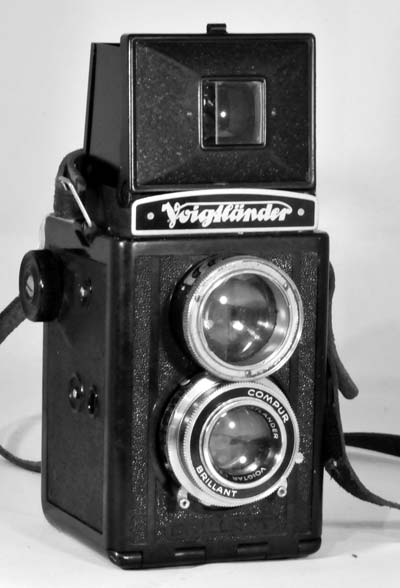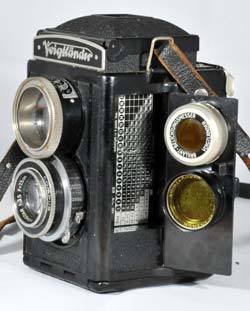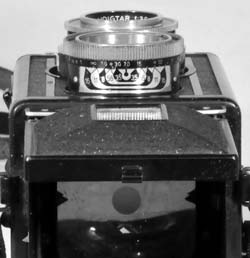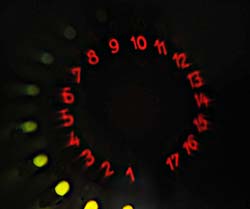Voigtländer Brillant - V6 Focussing
Specification

| Manufacturer | : | Voigtländer |
|---|---|---|
| Produced | : | 1938 |
| Classification | : | Medium Format |
| Body Type | : | Twin lens reflex |
| Construction | : | Bakelite |
| Film Type | : | 120 |
| Film Width | : | 62mm |
| Image Size | : | 6 x 6 cm |
| No. of Images | : | 12 |
| Lens Type | : | Voigtar |
| Aperture Type | : | Iris |
| Apertures | : | f/3.5 - f/16 |
| Focus Type | : | Variable |
| Focal Length | : | 75mm |
| Focal Range | : | 3.5ft - inf. |
| Shutter Type | : | Compur |
| Shutter Speeds | : | T,B, I(1/300s - 1s) |
| Size Open (w x h x d) | : | 90 x 175 x 95 mm |
| Size Closed (w x h x d) | : | 90 x 137 x 95 mm |
| Weight | : | 729g |
| Serial No. | : | 3773061 |
Art Deco Credentials
![]()
![]()
![]()
![]()
Significant: Pronounced and self evident
- produced during the main Art Deco period
- leather patterned Bakelite body
- vertical lines in bakelite on front and back moldings
- pyramid shaped viewfinder cover

Description

The Voigtländer Brillant is a range of mainly pseudo-TLR cameras that function more like box cameras, but the Brillant Focussing V6 is a true TLR camera. It takes 6 × 6 cm exposures on 120 film.
The first 1932 version of the Brillant had a metal body, but from 1937 Brillants were made of Bakelite. The Bakelite version was known as the Brillant V6. The following year saw the introduction of the focusing V6 Brillant as described here.
It has two viewfinder modes. There is a waist level brilliant finder and a sports type finder. When using the sports type finder, the photographer peers through a hole in the rear of the viewfinder towards a square lens in the front of the viewfinder giving an image with a full angle of view.
The Focussing Brillant has a small translucent ground glass spot in the viewfinder to focus on. The viewing and taking lens are coupled through gears. The body of the lens is turned until the subject is seen to be focussed on the ground glass. The exterior of the viewfinder lens mount has a depth of field scale indicating the zone of sharpness.
The Brillant V6 has an accessory compartment on the side. Typical accessories provided are a yellow filter and an extinction meter attachment. Yellow filters are indispensible for well-balanced pictures with correct tonal values, and particularly for attractive landscapes.

The extinction meter can be mounted on the viewfinder objective as a means of estimating correct exposure. When you look through the viewfinder you see two concentric rings, one having yellow/green dots and the other having red numbers to identify the dots. The user finds the number of the last green dot that is easily visible (8 in the illustratrion shown). A small table is found inside the accessory cupboard to convert the number to shutter speed and aperture setting combinations.
A range of shutter speeds are available including T,B and I(1/300s - 1s). There is a threaded connector for the attachment of a remote cable release. The 3-element lens has an iris type aperture that can be set to f/3.5, f/4, f/4.5, f/5.6, f/8, f/11 or f/16.
The camera has an automatic frame counter. The red window is only used to line up the first frame. Subsequently, the camera transport system will stop automatically at the next frame when the camera is wound on. This is particularly useful with modern film because of the sensitivity to light through the red window. Once the first frame has been selected using the red window, the cover on the red window can stay closed for the rest of the frames.
The camera has a single tripod mount on the base.
How to Use
Here is the manual for the Voigtlander Brillant V6. It is not the focussing type but it may be helpful.
Shutter speeds vary from 1/300s down to 1s. The aperture range is f/3.5 to f/16
If you don't want to bother with an exposure meter, follow the guide shown. It is based on the 'Sunny 16' rule. Film is so forgiving and will produce acceptable results even when overexposed by 2 or 3 stops or underexposed by 1 stop.
Remember that the exposure guide in the camera user manual may not be helpful as it is based on the use of old film with a low ISO value.
The tables assume that the sun is at least 30 degrees above the horizon - that's 10am - 5pm on a summer's day in the UK.
If you are not sure about the light level, err on the side of overexposure - i.e. assume the smaller f number.
Where there is a choice, a larger f number will give a larger depth of field.
For the slower speeds, you may need a tripod to stop blur through shake.
Using ISO 100/125 film
| Weather Conditions | Shadow Detail | Shutter Speed (s) | ||
|---|---|---|---|---|
| 1/50 | 1/100 | 1/300 | ||
 Sunny SunnySnow/Sand | Dark with sharp edges | f/11 | ||
 Sunny Sunny | Distinct | f/16 | f/8 | |
 Slight Overcast Slight Overcast | Soft around edges | f/16 | f/11 | f/5.6 |
 Overcast Overcast | Barely visible | f/11 | f/8 | f/4 |
 Heavy Overcast Heavy Overcast | None | f/8 | f/5.6 | f/3.5 |
 Open Shade Open Shade/Sunset | None | f/5.6 | f/4 | |